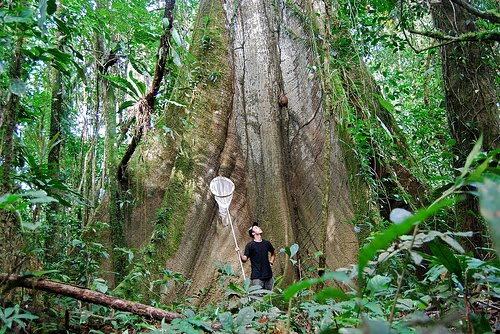The other day I spent my first full day at Tiputini Biodiversity Station (administered by Universidad San Francisco de Quito), about two hours further down the Tiputini River from the Yasuní Scientific Research Station (run by Catholic University in Quito). This site is even more remote than the YSRS, and the forest here is completely intact and totally pristine. All the big trees and big mammals are here, which are both indicators of a healthy ecosystem. There are even photos to prove it, results of an intensive camera trapping study conducted over the past several years (my favorite photo is of the ‘melanistic’, or black jaguar, captured by a camera on the very trail that I patrolled today for butterflies). Here there is no oil drilling, no hunting, no slash and burn – no disturbance whatsoever. Needless to say, this is a very exciting place to collect butterflies – or to conduct any other business for that matter!
One thing that I noticed after just a few days in Yasuní (at both sites actually) is that I was finding a higher diversity of butterflies in my traps and hand net than at my previous sites. Of course, the bulk of specimens are still represented by the usual suspects: a few very abundant brush-footed butterfly species (Nymphalids), and the ubiquitous flies, moths, and dung beetles. However, I am finding new butterfly species in the traps and net much more often here in the national park than at my other sites, where the forest is more disturbed (i.e. nearby slash and burn and clearcutting, extensive secondary forest, large animals basically hunted out). Based on such a short sampling period, and on relatively little effort, it is difficult to say why this might be. Can it be that a more undisturbed forest supports a higher diversity? Or am I collecting these rare ‘singletons’ solely due to chance? Hopefully some more rigorous analysis can shed some light on this question when I return from the field.


I was just in Tiputini, wonderful place!
ReplyDelete